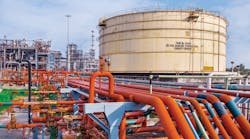Sam Fletcher
OGJ Online
HOUSTON, Dec. 4 -- A "collision of factors" ranging from recovery of demand growth to "the most onerous environmental requirements" restricting supplies will produce "a golden age" for refiners and marketers in 2003-2005, said Douglas Terreson, managing director for Morgan Stanley Dean Witter & Co., Tuesday.
The refining and marketing sector of the US oil industry also benefited from "supermajor" mergers that produced a "stronger, more disciplined, better managed group of companies," he told participants at the 22nd annual energy symposium sponsored by Arthur Andersen Inc. that opened Tuesday in Houston.
The financial performance of refiners and marketers during 2002 may dip below the record levels of 2000-01, Terreson reported. However, he predicted a major improvement as demand growth begins to rebound next year.
"The best is yet to come," agreed William E. Greehey, chairman and CEO of Valero Energy Corp., San Antonio, Tex., in that same session.
There has been no grassroots construction of a new US refinery in nearly 20 years, he said. Instead, refiners can increase production capacity to meet future demand growth only through expansions of existing plants.
That signals a great improvement in refiners' profit margins "for a long period," Greehey predicted. "As capacity tightens, the lows won't be as low or as prolonged, and the highs will be higher," he said.
However, Greehey said refiners still must exercise the discipline to adjust to market fluctuations. When profit margins for gasoline declined in the face of growing US inventory this year, he said, refiners began shutting down units for maintenance. That in turn depleted inventory and pushed prices back up.
The number of US refiners also has decreased significantly in recent years, with many of the smaller, low-margin refiners falling by the wayside. As a result, Greehey said, "The remaining refineries now have greater size and scope. So when one goes down for whatever reason, it has a greater impact on the market."
Terreson noted that the top five refiners now represent 50% of the North American market, up from 25% in 1996.
Kevin J. Lindemer, senior director of refined products and global downstream operations for Cambridge Energy Research Associates, was more conservative in his outlook, noting that "refining and marketing have always been demand challenged."
More stringent environmental requirements may effectively reduce refining capacity through a ban on methyl tertiary butyl ether, but it could also increase competition from renewable fuels, he said.
Technology, too, has been both "the greatest strength and the greatest threat" to the refining industry. It has been the greatest driver in improving refining efficiency and profitability while also triggering fuel substitutions, he said.
Lindemer predicted oil prices will remain in the low-$20/bbl range during the coming year among "continuing concerns whether we'll have a V-shaped recovery (in demand for refined products) in 2002."
He expects demand for refined products to grow by 300,000 b/d in the coming year with a dampened market for jet fuel, while Terreson projects a greater growth of 700,000 b/d.
Contact Sam Fletcher at [email protected]
